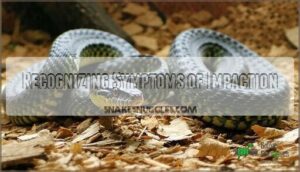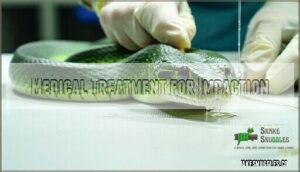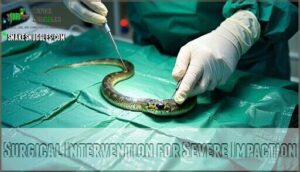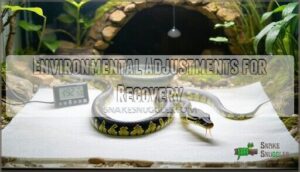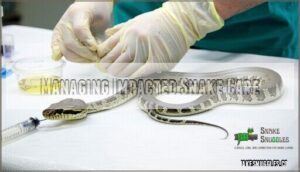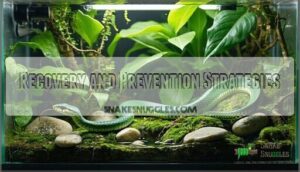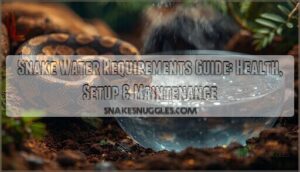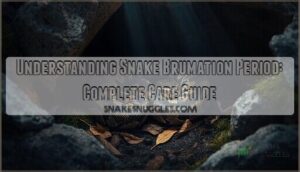This site is supported by our readers. We may earn a commission, at no cost to you, if you purchase through links.
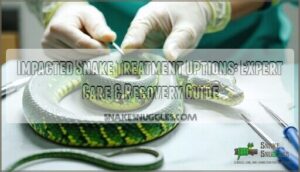
Impacted snake treatment options include veterinary-administered lubricants through feeding tubes, gentle abdominal massage, controlled warming, and rehydration therapy.
For severe cases, surgical removal becomes necessary. Don’t attempt home remedies like warm baths or manual manipulation, as these can worsen the condition.
Environmental adjustments, including proper humidity and temperature, support recovery. Dehydration often contributes to impaction, making fluid therapy essential.
Your vet might recommend dietary changes and feeding schedule modifications during recovery. Understanding the underlying causes and recognizing early warning signs can mean the difference between simple treatment and emergency surgery.
Table Of Contents
- Key Takeaways
- Snake Impaction Causes
- Identifying Impacted Snakes
- Treatment Options Available
- Managing Impacted Snake Care
- Recovery and Prevention Strategies
- Frequently Asked Questions (FAQs)
- How do you treat impaction in snakes?
- How do you treat impaction in reptiles?
- How to help a constipated reptile?
- How to tell if your snake is impacted?
- How much does snake impaction treatment cost?
- Can impacted snakes still drink water normally?
- What age snakes get impacted most often?
- How long does impaction recovery typically take?
- Are certain snake species more impaction prone?
- Conclusion
Key Takeaways
- Don’t attempt home treatments – Avoid warm baths, manual manipulation, or DIY remedies that can worsen your snake’s condition and cause serious complications.
- Seek immediate veterinary care – You’ll need professional diagnosis through X-rays and specialized treatments like fluid therapy, lubricants, or surgical removal for severe cases.
- Address underlying causes – Fix environmental factors like improper temperatures, low humidity, and dehydration that contribute to impaction development.
- Focus on prevention through proper husbandry – You can prevent future impaction by feeding appropriately-sized prey, maintaining correct temperatures and humidity, and providing clean water access.
Snake Impaction Causes
Understanding what causes impaction in your snake is the first step toward effective treatment.
Several factors can lead to this serious digestive blockage, from dietary issues to environmental conditions that affect your pet’s ability to process food properly, which can be considered a serious digestive issue.
Food Impaction in Snakes
Food impaction occurs when your snake can’t properly digest prey that’s too large for its digestive system.
Oversized prey creates gut motility problems, leading to snake bowel obstruction and serious digestive issues.
Poor enclosure hygiene compounds these problems by introducing harmful bacteria.
You’ll need to match prey size to your snake’s width, maintain proper temperatures for digestion, and guarantee clean feeding conditions.
Monitor supplementation needs carefully, as improper nutrition affects digestive function and can worsen snake constipation remedy efforts.
Dehydration and Impaction
Dehydration creates a domino effect in your snake’s digestive system. When water levels drop, fluid absorption decreases and osmotic balance shifts dramatically. This disrupts kidney function and creates shedding issues that compound digestive problems.
Dehydration turns your snake’s digestive system into a traffic jam of complications.
Here are five critical dehydration warning signs that demand immediate attention:
- Sunken eyes – Your snake’s eyes appear hollow or receded into the skull
- Sticky mouth – Saliva becomes thick and stringy, indicating severe fluid loss
- Wrinkled skin – The skin doesn’t snap back quickly when gently pinched
- Retained shed – Old skin clings stubbornly, especially around the tail and eyes
- Dark, concentrated urates – Waste products appear thick and paste-like instead of white
Poor water quality exacerbates these snake hydration therapy needs. Snake digestive issues worsen when dehydration slows food movement through the intestines. The combination creates perfect conditions for snake impaction causes to develop.
Treating snake impaction often begins with addressing fluid deficits through controlled rehydration protocols. Snake impaction relief frequently requires restoring proper hydration before other interventions prove effective.
Environmental Factors Causing Impaction
Temperature gradient disruptions create digestive chaos in your snake’s system.
Inadequate heating prevents proper digestion, while substrate ingestion from loose bedding causes blockages.
Humidity levels below 50% compound problems by reducing natural lubrication.
Cramped enclosure size limits movement needed for digestion, and poor lighting effects disrupt feeding cycles, creating multiple snake impaction causes requiring immediate attention.
Understanding a snake’s natural needs, such as appropriate snake habitats, is essential for preventing such immediate attention and natural needs issues, and ensuring proper snake’s system care.
Snake Impaction Due to Disease
Disease-related impaction threatens your snake’s health through multiple pathways.
Multiple disease pathways create dangerous digestive blockages requiring immediate veterinary intervention.
Inclusion Body Disease weakens digestive function, while parasites create physical blockages in the intestinal tract.
Bacterial infections cause organ failure and metabolic disorders that slow gut motility.
Snake Fungal Disease disrupts the microbiome, increasing constipation risk.
These conditions require immediate snake vet care and specialized impacted snake treatment protocols, providing vital animal care information through guides like vital animal care.
Identifying Impacted Snakes
You’ll notice specific warning signs when your snake develops impaction, ranging from obvious physical symptoms to subtle behavioral shifts.
Early identification is vital since prompt treatment substantially improves recovery outcomes and prevents serious complications.
This allows for prompt action to be taken, and is crucial for the snake’s health.
Recognizing Symptoms of Impaction
Spotting impacted snake symptoms requires careful observation of your reptile’s physical condition and behavior patterns.
Watch for these key warning signs that indicate reptile digestive health problems:
- Lethargy signs – Your snake becomes unusually inactive or sluggish
- Appetite loss – Complete refusal to eat for extended periods
- Regurgitation frequency – Repeated vomiting after feeding attempts
- Breathing difficulty – Labored or irregular respiratory patterns
Scale changes may also appear around the abdomen area.
These impacted snake symptoms often develop gradually, making early detection challenging but essential for effective reptile constipation cure.
Behavioral Changes in Impacted Snakes
Beyond recognizing symptoms, you’ll notice distinct behavioral shifts in your snake.
Lethargy signs become apparent as your pet moves less frequently, and appetite loss occurs when snakes refuse food for extended periods.
Hiding behavior intensifies, with snakes seeking dark spaces constantly, and activity changes include reduced exploration and basking.
These impacted snake symptoms warrant immediate reptile vet visit consideration for proper reptile impaction treatment evaluation.
Physical Signs of Impaction in Snakes
Your snake’s body reveals clear warning signs when impaction strikes. Physical examination shows distinct changes that signal digestive blockage requiring immediate reptile impaction treatment.
Watch for these critical indicators:
- Abdominal Swelling – Visible bulging along the snake’s midsection
- Scale Condition – Stretched, discolored scales over the impacted area
- Cloacal Issues – Swelling or discharge near the vent opening
- Breathing Difficulty – Labored respiration due to internal pressure
Regurgitation Signs may accompany these symptoms, indicating your pet needs snake constipation remedy intervention immediately.
Diagnostic Tests for Impaction
When visible symptoms suggest trouble, veterinary professionals use several diagnostic approaches to confirm impaction. Palpation Techniques help locate firm masses, while Imaging Modalities like X-rays provide clear internal views. Fecal Analysis rules out parasites, and Endoscopy Use offers direct visualization. Contrast Radiography enhances blockage detection when standard methods fall short.
A vet might also check for signs of lethargy to help diagnose impaction.
| Diagnostic Method | Key Benefit |
|---|---|
| Radiographs (X-rays) | 85% detection rate for blockages |
| Ultrasound Imaging | Differentiates impaction from tumors |
| Endoscopic Evaluation | Direct visualization and potential retrieval |
Schedule a reptile vet visit immediately if you suspect issues. These tests guide whether your snake needs a snake enema, specific reptile constipation relief, or other snake constipation remedy options for effective reptile impaction prevention.
Treatment Options Available
When your snake shows signs of impaction, you’ll need to act quickly with the right treatment approach.
The severity of the condition determines whether medical intervention, dietary changes, or environmental adjustments will provide the best path to recovery.
Medical Treatment for Impaction
Your veterinarian will develop a customized medical approach when your snake faces impaction.
Fluid therapy helps soften blockages while pain management keeps your pet comfortable during recovery. Laxative use may assist passage, though enema options require professional administration.
Snake mineral oil provides lubrication, and probiotics support digestive health.
A key factor is to guarantee proper enclosure humidity to help prevent impaction.
Always schedule a reptile vet visit for proper snake digestive support and reptile constipation relief rather than attempting home remedies for reptile impaction prevention.
Surgical Intervention for Severe Impaction
When conservative treatments fail, surgical removal becomes necessary for severely impacted snakes.
Veterinarians use specialized anesthesia protocols and precise incision techniques during reptile impaction surgery.
Snake mineral oil may supplement recovery, but surgery addresses complete blockages. Products aid recovery post-surgery.
Post-op complications require careful pain management and structured recovery timeline monitoring. Professional snake treatment guarantees your reptile’s digestive support returns to normal function safely.
Dietary Changes for Impacted Snakes
Through careful dietary adjustments, you’ll help your impacted snake heal while preventing future blockages.
Smaller prey size reduces digestive strain, while controlled feeding frequency allows proper processing. You’ll need to focus on hydration methods and monitor fiber intake carefully.
Many keepers find that appropriately sized meals can prevent impaction.
- Smaller prey size – prevents additional packing in already wedged digestive tract
- Reduced feeding frequency – allows time for impacted material to clear naturally
- Increased hydration methods – softens wedged matter for easier passage
- Controlled fiber intake – prevents further digestive complications
- Veterinary-approved supplementation – supports recovery without surgical intervention
Environmental Adjustments for Recovery
Recovery environments require precise adjustments to support healing. You’ll need to create favorable conditions that aren’t entrenched in old habits but focus on your snake’s specific needs.
| Environmental Factor | Recovery Setting | Monitoring Focus |
|---|---|---|
| Temperature Gradients | 78-88°F with proper basking | Check daily for consistency |
| Humidity Levels | 50-60% to prevent dehydration | Measure twice weekly |
| Substrate Choices | Paper towels (avoid packing materials) | Replace when soiled |
Proper heating is often achieved with a reptile heat source. Adjust Lighting Schedule to natural cycles, provide adequate Hiding Places to reduce stress, and make certain nothing becomes wedged in tight spaces that could cause fracture or further impaction issues.
Managing Impacted Snake Care
Once you’ve identified impaction in your snake, proper management becomes essential for successful recovery.
You’ll need to create ideal conditions while monitoring your snake’s progress and implementing strategies to prevent future episodes, which is crucial for successful recovery.
Providing a Suitable Environment
Your impacted snake’s recovery depends on creating an environment that supports healing like closely united bones after a fractured bone heals.
Temperature gradients between 75-85°F help digestion, while humidity control at 50-60% prevents dehydration.
Choose proper enclosure size with soft substrate selection to avoid further injury.
Add multiple hiding places to reduce stress during medical conditions recovery, and ensure the environment is conducive to healing with proper care and humidity control.
Hydration and Nutrition for Impacted Snakes
When providing adequate hydration, make certain you’re offering clean water through soaking baths or misting systems, as poor water quality can worsen medical conditions.
Adjust feeding frequency and prey size based on your snake’s current digestive capacity.
Focus on gut health through gentle supplementation strategies while avoiding foods that could aggravate impacted areas like fractured bone fragments.
Monitoring and Handling Impacted Snakes
Gentle observation techniques help you monitor your impacted snake’s condition without adding stress.
Watch for changes in breathing patterns, activity levels, and posture during daily health checks.
Use safe handling methods that minimize movement—supporting the body properly reduces discomfort.
Keep detailed records of medical treatment progress, including feeding attempts and bowel movements.
Quarantine protocols guarantee your snake receives focused medical care while preventing potential complications from environmental stressors.
Proper care includes understanding snake habitat requirements and providing a suitable environment for recovery, which is crucial for improving health and reducing stress, and ultimately supporting the body.
Preventing Future Impaction in Snakes
Three simple steps prevent future impaction episodes in your snake.
First, quarantine new snakes for thirty days to avoid introducing parasites or diseases that cause digestive blockages.
Second, manage substrate carefully—avoid loose materials like sand that become packed in the intestinal tract, similar to wisdom teeth getting wedged in jaw spaces.
Third, control prey size, humidity levels, and consider probiotics use for ideal digestive health.
Recovery and Prevention Strategies
Once you’ve successfully treated your snake’s impaction, focusing on recovery and long-term prevention becomes essential for their health.
Proper post-treatment care combined with preventive measures will help guarantee your snake recovers fully and doesn’t experience impaction again, which is crucial for their overall health.
Post-treatment Care for Impacted Snakes
After successfully managing your impacted snake’s immediate needs, you’ll shift focus to recovery monitoring.
Wound care becomes your top priority if surgical intervention occurred. Follow your veterinarian’s medication schedule precisely, administering antibiotics or pain relievers as directed.
Watch for returning appetite and provide appetite stimulation through gentle handling when appropriate.
Monitor shedding assistance needs, as stress can affect this process. Maintain behavioral monitoring to catch any setbacks early, ensuring overall health and well-being.
Preventing Impaction Through Proper Feeding
After your snake recovers, you’ll want to prevent future impaction episodes by establishing proper feeding protocols.
The dictionary definition of impacted means "wedged together," and understanding this word meaning helps explain why feeding practices directly affect your snake’s health.
Follow these feeding guidelines to maintain proper digestive health:
- Prey size: Offer food items no wider than your snake’s thickest body section
- Food source: Provide pre-killed frozen-thawed prey rather than live animals
- Feeding frequency: Feed juveniles weekly, adults every 10-14 days based on species
- Supplementation needs: Avoid calcium powder unless veterinarian-recommended
- Gut loading: Make certain feeder rodents ate nutritious food before freezing
Proper feeding prevents the wedged blockages that create impacted conditions in your pet’s digestive system.
Maintaining a Healthy Environment for Snakes
Your snake’s environment serves as the foundation for preventing future impaction episodes.
Proper Ventilation guarantees fresh airflow while maintaining stable Temperature Gradient zones from basking to cool areas.
Monitor Humidity Levels carefully – too dry affects digestion, too wet promotes bacterial growth.
Choose appropriate Enclosure Size allowing natural movement patterns.
Select digestible Substrate Choice avoiding loose materials that cause impacted conditions.
Maintaining the correct environment includes daily spot cleaning to remove waste.
These environmental factors, by dictionary definitions, directly influence your pet’s digestive health and overall wellbeing.
Regular Veterinary Check-ups for Snakes
Beyond initial treatment, establishing a routine checkup schedule helps catch problems before they become serious.
Regular veterinary visits allow for thorough health monitoring and early detection of impacted conditions, similar to how dental health requires consistent preventative care.
- Schedule checkups every 6-12 months for healthy adult snakes
- Increase frequency to quarterly visits for older or previously impacted snakes
- Seek expert advice immediately if you notice changes in eating or elimination patterns
Frequently Asked Questions (FAQs)
How do you treat impaction in snakes?
Like a clogged drain backing up water, an impacted snake can’t pass waste normally.
You’ll need a warm bath, gentle massage, and possibly a vet visit for severe cases requiring manual removal.
How do you treat impaction in reptiles?
You’ll need to consult an exotic veterinarian immediately if you suspect impaction.
They might recommend warm soaks, gentle massage, increased humidity, dietary changes, or in severe cases, surgical intervention to remove the blockage.
How to help a constipated reptile?
Increase your reptile’s water intake through soaks and misting.
Provide gentle belly massage and encourage movement.
Offer high-fiber foods like pumpkin. Verify proper temperatures for digestion.
Consult a reptile veterinarian if constipation persists.
How to tell if your snake is impacted?
Spotting signs of snake impaction? You’ll notice prolonged constipation, abdominal swelling, lethargy, and loss of appetite. Your snake may strain without producing waste or show visible lumps along its belly.
How much does snake impaction treatment cost?
Snake impaction treatment costs vary substantially, ranging from $300-$2,000 depending on severity. Minor cases requiring medication may cost $300-$600, while surgical removal can reach $1,000-$2,000 at specialized exotic veterinarians.
Can impacted snakes still drink water normally?
Impacted snakes typically can’t drink water properly since the blockage prevents normal swallowing and digestion. You’ll notice they may attempt drinking but struggle with retention and processing fluids effectively.
What age snakes get impacted most often?
Roughly 70% of impaction cases occur in juvenile reptiles under one year old.
You’ll find that young snakes are most vulnerable due to their tendency to accidentally ingest substrate while feeding and their developing digestive systems.
How long does impaction recovery typically take?
Recovery time varies based on severity, but you’ll typically see improvement within 3-7 days with proper treatment.
Complete healing usually takes 1-2 weeks.
Monitor your snake’s appetite and bathroom habits closely during this period, ensuring a smooth recovery.
Are certain snake species more impaction prone?
Yes, certain species like ball pythons and boas face higher impaction risks due to their slower metabolisms, infrequent feeding schedules, and tendency to consume substrate accidentally while hunting prey.
Conclusion
Successful recovery depends on three critical factors: early recognition, appropriate treatment, and diligent post-care monitoring.
You’ll need professional veterinary intervention, environmental optimization, and ongoing prevention strategies to guarantee your snake’s health.
The most effective impacted snake treatment options combine medical expertise with proper husbandry practices.
Remember that prevention through correct feeding schedules, adequate hydration, and ideal temperatures prevents most impaction cases.
Quick action and professional care make the difference between simple treatment and complex surgical intervention, which is why professional care is essential.
- https://www.thinkglobalhealth.org/article/antivenom-plan-india
- https://www.nature.com/articles/s41586-024-08393-x
- https://pmc.ncbi.nlm.nih.gov/articles/PMC6073149/
- https://journals.plos.org/plosntds/article?id=10.1371%2Fjournal.pntd.0009464
- https://docs.google.com/forms/d/1GAQr3Kn1cURCVHUA82hAga1Wv8DCH0IuqDLRUrOpN7M/viewform?ts=63f4f653&entry.1515682415=https://www.merriam-webster.com/dictionary%2Fimpacted

